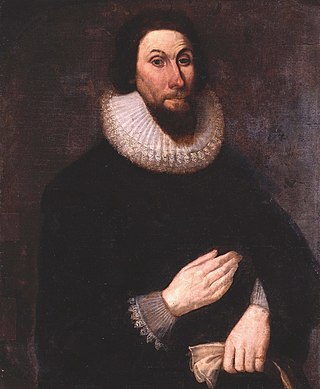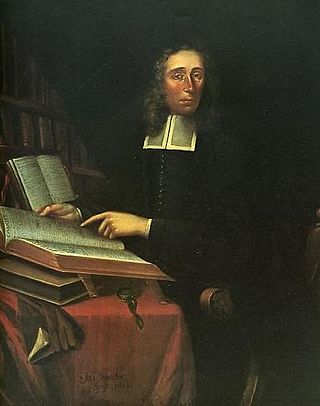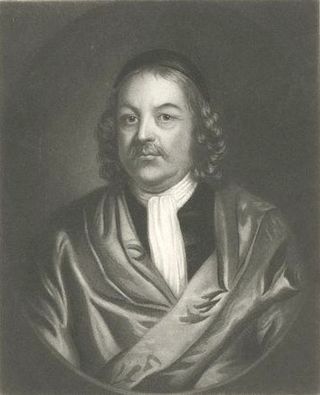Related Research Articles

The Pilgrims, also known as the Pilgrim Fathers, were the English settlers who traveled to America on the Mayflower and established the Plymouth Colony in Plymouth, Massachusetts. The Pilgrims' leadership came from the religious congregations of Brownists, or Separatists, who had fled religious persecution in England for the tolerance of 17th-century Holland in the Netherlands.

John Winthrop was an English Puritan lawyer and a leading figure in the founding of the Massachusetts Bay Colony, the second major settlement in New England following Plymouth Colony. Winthrop led the first large wave of colonists from England in 1630 and served as governor for 12 of the colony's first 20 years. His writings and vision of the colony as a Puritan "city upon a hill" dominated New England colonial development, influencing the governments and religions of neighboring colonies in addition to those of Massachusetts.

The Massachusetts Bay Colony (1628–1691), more formally the Colony of Massachusetts Bay, was an English settlement on the east coast of North America around the Massachusetts Bay, one of the several colonies later reorganized as the Province of Massachusetts Bay. The lands of the settlement were in southern New England, with initial settlements on two natural harbors and surrounding land about 15.4 miles (24.8 km) apart—the areas around Salem and Boston, north of the previously established Plymouth Colony. The territory nominally administered by the Massachusetts Bay Colony covered much of central New England, including portions of Massachusetts, Maine, New Hampshire, and Connecticut.

Plymouth Colony was the first permanent English colony in New England from 1620 and the third permanent English colony in America, after Newfoundland and the Jamestown Colony. It was settled by the passengers on the Mayflower at a location that had previously been surveyed and named by Captain John Smith. The settlement served as the capital of the colony and developed as the town of Plymouth, Massachusetts. At its height, Plymouth Colony occupied most of the southeastern portion of Massachusetts. Many of the people and events surrounding Plymouth Colony have become part of American folklore, including the American tradition of Thanksgiving and the monument of Plymouth Rock.

Increase Mather was a New England Puritan clergyman in the Massachusetts Bay Colony and president of Harvard College for twenty years (1681–1701). He was influential in the administration of the colony during a time that coincided with the notorious Salem witch trials.

The New Haven Colony was a small English colony in Connecticut Colony from 1638 to 1664, with outposts in New York, New Jersey, Pennsylvania, and Delaware.

Cape Ann is a rocky peninsula in northeastern Massachusetts on the Atlantic Ocean. It is about 30 miles (48 km) northeast of Boston and marks the northern limit of Massachusetts Bay. Cape Ann includes the city of Gloucester and the towns of Essex, Manchester-by-the-Sea and Rockport.

Simon Bradstreet was a New England merchant, politician and colonial administrator who served as the last governor of the Massachusetts Bay Colony. Arriving in Massachusetts on the Winthrop Fleet in 1630, Bradstreet was almost constantly involved in the politics of the colony but became its governor only in 1679.

William Stoughton was a New England Puritan magistrate and administrator in the Province of Massachusetts Bay. He was in charge of what have come to be known as the Salem Witch Trials, first as the Chief Justice of the Special Court of Oyer and Terminer in 1692, and then as the Chief Justice of the Superior Court of Judicature in 1693. In these trials he controversially accepted spectral evidence. Unlike some of the other magistrates, he never admitted to the possibility that his acceptance of such evidence was in error.

The New England Colonies of British America included Connecticut Colony, the Colony of Rhode Island and Providence Plantations, Massachusetts Bay Colony, Plymouth Colony, and the Province of New Hampshire, as well as a few smaller short-lived colonies. The New England colonies were part of the Thirteen Colonies and eventually became five of the six states in New England, with Plymouth Colony absorbed into Massachusetts and Maine separating from it.
William Phelps, was a Puritan who emigrated from Crewkerne, England in 1630, one of the founders of both Dorchester, Boston Massachusetts and Windsor, Connecticut, and one of eight selected to lead the first democratic town government in the American colonies in 1637. He was foreman of the first grand jury in New England, served most of his life in early colonial government, and according to noted historian Henry Reed Stiles, Phelps "was one of the most prominent and highly respected men in the colony."

John White was an English clergyman, the rector of a parish in Dorchester, Dorset. He was instrumental in obtaining charters for the New England Company and the Massachusetts Bay Company. He took a personal interest in the settlement of New England.
Matthew Cradock was a London merchant, politician, and the first governor of the Massachusetts Bay Company. Founded in 1628, it was an organization of Puritan businessmen that organized and established the Massachusetts Bay Colony. Although he never visited the colony, Cradock owned property and businesses there, and he acted on its behalf in London. His business and trading empire encompassed at least 18 ships, and extended from the West Indies and North America to Europe and the Near East. He was a dominant figure in the tobacco trade.
Thomas Gardner was an Overseer of the "old planters" party of the Dorchester Company who landed in 1624 at Cape Ann to form a colony at what is now known as Gloucester. Gardner is considered by some to have been the first Governor of Massachusetts, due to his being in authority in the first settlement that became the Massachusetts Bay Colony.
The Old Planters of Massachusetts were settlers of lands on Massachusetts Bay that were not part of the two major settlements in the area, the Plymouth Colony (1620), and the Massachusetts Bay Colony.

In the early 17th century, thousands of English Puritans settled in North America, almost all in New England. Puritans were intensely devout members of the Church of England who believed that the Church of England was insufficiently reformed, retaining too much of its Roman Catholic doctrinal roots, and who therefore opposed royal ecclesiastical policy. Most Puritans were "non-separating Puritans" who believed there should be an established church and did not advocate setting up separate congregations distinct from the Church of England; these were later called Nonconformists. A small minority of Puritans were "separating Puritans" who advocated setting up congregations outside the Church. The Pilgrims were a Separatist group, and they established the Plymouth Colony in 1620. Puritans went chiefly to New England, but small numbers went to other English colonies up and down the Atlantic.

The English overseas possessions, also known as the English colonial empire, comprised a variety of overseas territories that were colonised, conquered, or otherwise acquired by the former Kingdom of England during the centuries before the Acts of Union of 1707 between the Kingdom of England and the Kingdom of Scotland created the Kingdom of Great Britain. The many English possessions then became the foundation of the British Empire and its fast-growing naval and mercantile power, which until then had yet to overtake those of the Dutch Republic, the Kingdom of Portugal, and the Crown of Castile.
John Humphrey was an English Puritan and an early funder of the English colonisation of North America. He was the treasurer of the Dorchester Company, which established an unsuccessful settlement on Massachusetts Bay in the 1620s, and was deputy governor of the Massachusetts Bay Company from 1629 to 1630. He came to Massachusetts in 1634, where he served as a magistrate and was the first sergeant major general of the Ancient and Honorable Artillery Company. He became involved in English attempts to settle Providencia Island in the late 1630s, and returned to England in 1641 after financial reverses and probable religious differences with other members of the Massachusetts ruling elite. He then became involved in an attempt to settle The Bahamas in the late 1640s, and had some involvement in the politics of the English Civil War.

The Charter of the Massachusetts Bay Company was an English royal charter which formally incorporated the joint-stock company for the colonization of Massachusetts Bay. The charter, granted by Charles I of England in 1628, defined the regulations of the company, the land it would be granted, as well as the rights and privileges of the colonists.
References
- ↑ "Dorchester Company of Adventurers". Oxford Reference. Oxford University. Retrieved 16 June 2023.
- ↑ Goff, John (2009). Salem's Witch House: A Touchstone to Antiquity. Arcadia Publishing. p. 1625. ISBN 978-1-61423-286-5.
- ↑ Palfrey, John G. "The Great Puritan Migration to New England – History Moments". historyweblog.com. Retrieved 16 June 2023.
- 1 2 3 Moe, Barbara (2003). The Charter of the Massachusetts Bay Colony: A Primary Source Investigation into the 1629 Charter. New York, NY: The Rosen Publishing Group, Inc. p. 35. ISBN 978-0-8239-3801-8.
- 1 2 Robbins, William G. (1969). "The Massachusetts Bay Company: An Analysis of Motives". The Historian. 32 (1): 83–98. doi:10.1111/j.1540-6563.1969.tb01138.x. ISSN 0018-2370. JSTOR 24440500.
- ↑ Delahaye, Agnès (2020). Settling the Good Land: Governance and Promotion in John Winthrop’s New England (1620–1650). Leiden: BRILL. p. 94. ISBN 978-90-04-43139-3.